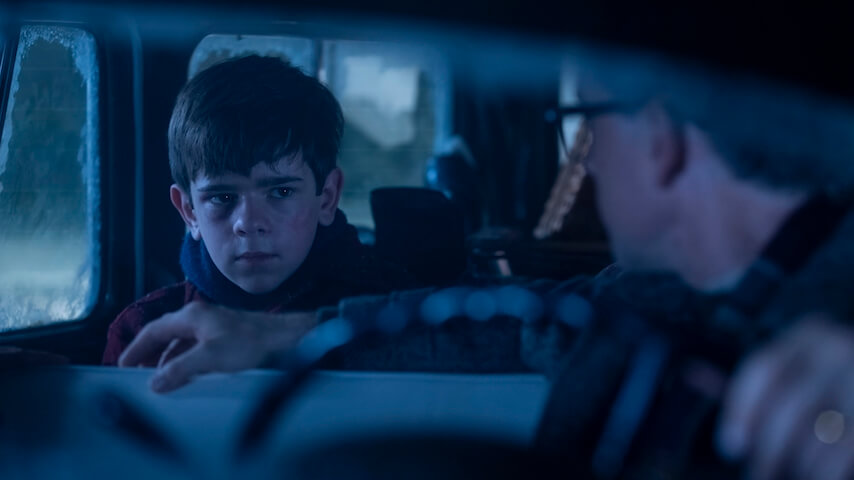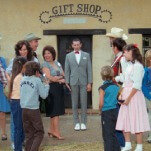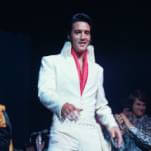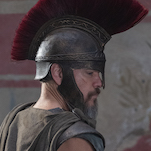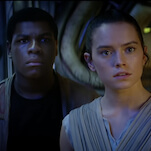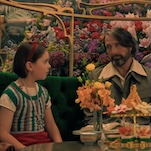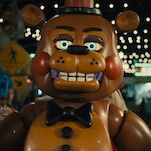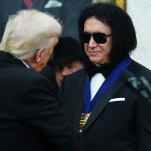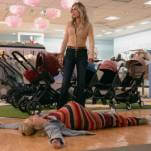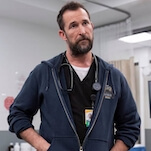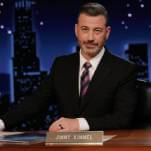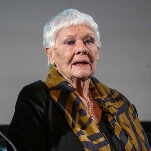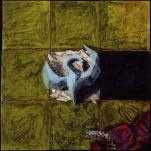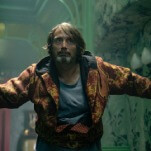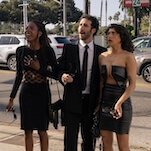[Editor’s note: Episode two of IT: Welcome To Derry arrives on HBO Max on October 31. Our recap of the hour will publish that day.]
There are two things that any adaptation, prequel, sequel, or imaginary story that’s rooted itself in the power of Stephen King’s IT has got to manage. It’s got to be nightmarish—not just scary or shocking because scares and shocks are cheap coin that spends easy in the realm of horror, but nightmarish, dream logic in the worst, most creeping of ways, as that’s how “this spooky clown wants to kill you” goes from goofball comedy to shit that sticks in a reader’s brain for life. And you’ve got to get the kids right, which is probably even harder, if IT director Andy Muschietti’s new TV prequel to his own blockbuster duology, Welcome To Derry, is anything to go by.
We open in early 1962, and in fairly fine form, as a young kid named Matty Clements (Miles Ekhardt) attempts to steal a little happiness from an unkind world. As we know from overheard chatter—one thing we’ll learn early, and often, in Derry is that its residents love speaking in expository shorthand—Matty comes from a crappy home, so why not sneak into a theater to enjoy a few minutes of the Robert Preston version of The Music Man? After a brief altercation with an overly dogmatic usher (and a save from the projectionist’s daughter), Matty decides to bid Derry farewell forever, sticking out his thumb and having the apparent good luck to hitch a ride with a family exuding an aura of nuclear good cheer.
What follows is the Welcome To Derry pilot’s one truly affecting scene, as Muschietti—who directs here, working from a script by Argylle’s Jason Fuchs—keeps a steady hand on the tension knob until just long enough for it to be time to rip the fucker off. The family is a little weird initially, sure, but so is Matty, who self-soothes by sucking noisily on a pacifier and can only answer questions about where he wants to go with “anywhere but Derry.” It’s not until the daughter starts casually toying with a home-packed tub of “LIVER” that alarm bells start going off, as she threatens to smear their passenger/prisoner with blood. By then, you start to notice the increasingly manic gleam in each character’s eyes, the too-chipper tone, the rising cacophony of spelling words and ugly recriminations—and that’s before Mother begins giving instant, screaming, exultant birth. With the doors locked and the cheerful screaming only rising in tone, Matty—who has unwittingly found himself the central figure of what would in other circumstances be a great little horror short—has no choice but to close his eyes, block his ears, and pray the nightmare sufferer’s last resort: Please let this not be real.
No such luck, as we jump simultaneously through the show’s opening titles and four months of time, as Derry has very quickly gotten over the disappearance of one whole entire boy. The only exceptions to the “move on and forget about it” crowd are those kids who were closest to Matty Clements, and even that’s a relative distinction. “Loony” Lilly Bainbridge (Clara Stack) seems to have had some genuine affection for the kid, if a later flashback to New Year’s Eve is anything to go off. But young comic nerd Teddy Uris (Mikkal Karim-Fidler) and his conspiracy-theory buddy Phil (Jack Molloy Legault) are wrestling, in part, with the fact that they didn’t know Matty all that well and only hung out with him out of a blend of pity and treat-based bribery. Nevertheless, they find themselves steadily drawn into the investigation into his death—not least of which because it’s been 27 years since the last time something targeted Derry’s children, and IT’s got them in its sights.
But it’s here, unfortunately, where we’re going to have to address the single biggest problem that’s dragging Welcome To Derry down in its initial offering: Its total inability to make these kids feel authentic, either as horror protagonists, 1960s residents, or even just living, speaking beings. Muschietti had some decent success with this kind of thing in the IT movies, but he was working with both a better caliber of script and a blockbuster movie-level of casting power: Stack, Karim-Fidler, Legault, and Amanda Christine (who has less to do here as the aforementioned projectionist’s daughter, Ronnie, eventually roped into the situation as one of the last people to see Matty alive) all have decent enough stage presence. But they wrestle with a script that has no grasp of how to make these characters sound like human beings,and staging that often feels more akin to sitcom work than drama or horror. Mock some of King’s folksy affectations (and stranger plotting choices) if you like, but the man is one of the most razor-sharp writers of dialogue to ever publish. His version of the Losers Club felt real, to a kid, allowing horror to anchor in the audience’s affection for them. Fuchs’ script can’t even come close to matching it, instead sounding, well, the way a screenwriter might imagine kids talking to each other: quippy, weightless, and written in the cadences of punchlines and clichés, rather than human feeling. The effort to launder such weak material strands the show’s young cast in the weeds for huge chunks of “The Pilot.”
Some of that looseness of characterization might also be a consequence of the episode’s nastiest structural trick: the way it races to build up this bargain-bin version of the Loser’s Club just so it can tear through them at the episode’s climax. It’s a bold decision, even if having Phil and Teddy get apparently slaughtered by the mutant baby from the hour’s opening, just one episode into their tenure as “main characters,” can’t match the somnambulistic horror of that earlier sequence. (It’s possible I’ve watched Dead Alive one too many times to find a grotesque murder baby anything but amusing, even as it’s ripping off little kids’ arms.) Burning through characters it spent a huge amount of its running time developing does give Welcome To Derry’s first episode a sense of genuine unpredictability that’s valuable. At the same time, it makes it even easier to dismiss these characters as lightly sketched-in stereotypes of King-type (or, if I’m being less charitable, Stranger Things-type) child heroes.
It also feeds into the episode’s other big oddity, one that’s been reflected in the structure of this review itself: the whole other, completely disconnected plotline happening during its run, focused on its apparent adult lead, Air Force Major Leroy Hanlon. (portrayed by Jovan Adepo, playing a character tackled by Steven Williams in IT.) Besides young plane-watcher Phil being obsessed with the goings-on at the local air base, Leroy exists in what is functionally a whole other TV show than the one focused on the kids, facing off against a racist flight crew member, getting wooed by military official James Remar, and ultimately being the subject of a bizarre night-time attack by gas-mask wearing thugs who want him to reveal secrets about the military plane he’s been brought to Derry to test. Adepo imposes a quiet confidence on Leroy—despite being forced to share scenes with Rudy Mancuso, who’s basically playing a cartoon—but his adventures on the base have no apparent connection to the shaggy-dog story the show is telling with the kids. Muschietti and Fuchs seem completely disinterested in even having these two plotlines rhyme, and it contributes to a messy sense of walking into a show while the table’s still being set.
Along with the aforementioned woes of its child actors, it’s that lack of cohesion that hurts Welcome To Derry the most in this initial outing. There are dollops of themes being tossed around here—most notably the pervading threat of nuclear war, with the series taking place just six months before the outbreak of the Cuban Missile Crisis. But these arrive more as name-checks than ideas, with an antagonist content to amuse itself with gory monster babies than anything more evocative of genuine horror. (See also the show’s early fumblings toward addressing Leroy’s difficulties as a Black man in the 1960s military, which show up here as pretty much just one asshole mechanic and some ominous looks from Perry Mason star Chris Chalk. Viewers hoping the show would dive in more deeply to King’s ideas about how IT uses the prejudices, hatred, and indifferent blind eyes of its flock to empower itself—exemplified in the book’s description of the burning of the Black Spot nightclub in the 1930s—won’t be getting it in this specific episode, at least.) If Welcome To Derry is going to be something more than “IT in eight episodes instead of two movies”—and there is some suggestion, with that ruthless ending, that that’s the intended goal—it’s going to need a level of focus that’s lacking here. As is, we’ve got some effective scares, but acting, and especially writing, that can’t live up to the series’ pedigree.
Stray observations
- • The show’s use of The Music Man is anachronistic. Matty’s watching it right after New Year’s in 1962, while the film didn’t arrive in theaters until June.
- • There are some impressively gross gore effects with the pregnancy sequence in that initial horror show car ride.
- • The show holds off on Pennywise here, with IT acting through other guises. It’ll be interesting to see how much restraint is applied to the creature’s most iconic manifestation.
- • The series all but sleepwalks through its kids’ various motivating traumas and their conflicts with their parents. Lilly has a “Phoebe Cates talking about her dead dad in Gremlins” monologue about her own father getting mulched up at the pickle factory; Teddy has a hard-ass rabbi dad who hates comic books. We don’t see Phil’s parents, but he’s got a little sister who winds up getting Georgie Denbrough’d.
- • As for connections to the wider mythos, Teddy is obviously related to Stan from future Losers Club fame, while Leroy is the grandfather of member Mike. We also get a few glimpses of Chalk as Dick “Scatman Crothers in The Shining” Hallorann, who had a cameo in King’s novel in the aforementioned Black Spot interlude. (This has been moved up to 1962 in the timeline changes that happened when Muschietti shifted IT forward 30 years for his movies.) And the school’s mascot being a turtle ties into some of King’s wider cosmology about benevolent, but passive, forces that can be invoked for protection against the very active monsters of this universe.
- • Going back through the episode to write down memorable quotes, I was struck much more aggressively by how rough and labored so many of the line readings are. Matty’s “You couldn’t have known, it was a terrible accident” to Lilly was an obvious one, but the early fight between Teddy and Phil has its share of clunkers, too.
- • We get some suggestions that Lilly might have a crush on her friend Marge, but, again, no real interest in tackling the deeper implications here; it’s loose “outsider” coding, not much deeper than Marge’s own thick glasses.
- • Shout-out to Anna Bura, listed as “Fart Girl” in the credits. Someone has to play the Fart Girls of the world.
- • Teddy’s been sneaking reads of the iconic The Flash #123, the comic that introduced the multiverse to the DC Comics universe. (It was published September 1961, but maybe he’s a slow reader.)
- • Another effective (if less well-executed) horror beat happens immediately afterward, as IT takes advantage of Teddy’s latest dad-inflicted horrific mental image by showing up as a lampshade of human faces.
- • The reveal that Lilly is holding little Susie’s hand is a cheap trick, but not an ineffective one.
